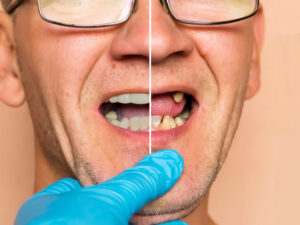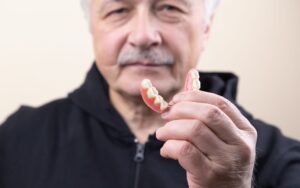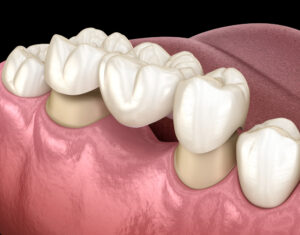What are the Best Ways to Replace Multiple Missing Teeth?
 As dental professionals, we take our role in preserving the health of teeth seriously. We want every patient to keep every tooth possible. However, we also understand that conditions arise when it is impossible to save teeth. Also, situations exist in which the teeth were pulled at some point in the past.
As dental professionals, we take our role in preserving the health of teeth seriously. We want every patient to keep every tooth possible. However, we also understand that conditions arise when it is impossible to save teeth. Also, situations exist in which the teeth were pulled at some point in the past.
For that reason, when we cannot preserve natural teeth, we excel at replacing them and restoring the mouth back to optimal health.
Why Should You Replace Missing Teeth?
There are multiple advantages to replacing missing teeth. The topic is so big that we could spend an entire blog solely covering it. For our purposes here, we’ll simply cover a few of the most important reasons that you should consider replacing missing teeth.
- Preservation of Remaining Natural Teeth – When you replace missing teeth, you are actually protecting and preserving the other natural teeth in your mouth. Missing multiple teeth causes a shift in the chewing force onto the remaining teeth. The design of each tooth enables it to withstand a certain (and limited) amount of chewing force. When you lose multiple teeth, the teeth left in the mouth receive more force than their design allows. This leads to consequences like cracked teeth, gum recession, and eventual loss of these remaining teeth.
- Improved Chewing Ability – When you replace the missing teeth with prosthetic options, you redistribute the chewing forces. The replacement teeth add surface area for chewing and grinding food. People often do not realize how poorly they are able to chew their food until after they replace missing teeth.
- Improved Digestion – Chewing is the first step in the digestive process. Not only does chewing physically break large food particles down into smaller; there are enzymes in saliva that chemically break down molecules in the food. Without proper chewing, you can actually suffer malnutrition.
- Improved Appearance – Missing teeth, even in the back of the mouth, affect the appearance of the face. Missing molars can give a sunken appearance to the cheeks. Missing back teeth can allow the bite to collapse, causing lines and wrinkles on the face. To be frank, missing teeth make you look old.
You Have Options!
At Designer Smiles, we love dental implants, and in many cases, they are the absolute best tooth replacement option. However, they are never the only option. While we will honestly tell you which option we would choose for our own mouths in the same situation, we never choose for you.
When it comes to replacing multiple missing teeth, we can break the options into a few categories.
 Removable Prosthetic Teeth – Commonly called a “partial”, these removable appliances contain prosthetic teeth and small clasps that hold onto remaining teeth for support.
Removable Prosthetic Teeth – Commonly called a “partial”, these removable appliances contain prosthetic teeth and small clasps that hold onto remaining teeth for support.- Fixed (glued-in) Prosthetic Teeth using Natural Teeth for Support – We usually call these “bridges”, and they use crown-like attachments onto neighboring teeth to connect the prosthetic teeth replacements.
- Fixed Pros thetic Teeth supported by Dental Implants – When someone is missing more than two teeth in a row, we can replace them with a bridge that uses dental implants as the “book-ends” and support. This option requires no healthy natural teeth because all of the support is from the implants within the jawbone.
The Remaining Teeth Matter
The condition of the remaining natural teeth (in the same dental arch as the missing teeth) does matter. Both partials and tooth-supported bridges require natural teeth with a solid foundation. These two teeth replacement options rely on the remaining teeth for both retention (staying in the mouth) and support (being able to chew). They must have healthy solid tooth structure above the gums and healthy attachment between the roots and the surrounding tissues.
One disadvantage of any teeth replacement option that uses natural teeth for support is that it places added stress on the remaining natural teeth. Over time, the teeth supporting the partials and bridges may suffer wear and tear that they would not suffer if they were not bearing the additional burden of prosthetic teeth.
Cost vs. Long-Term Success
In general, you can assume that the more expensive a treatment option is, the longer it will last. Of the categories discussed above, the least expensive is the removable prosthetic teeth. These dental appliances can replace any number of missing teeth, and the cost does not change. Typical costs of a removable partial is around $2000, regardless of how many teeth it replaces. The reason their long-term success rate is not great is due to the risk of loss of additional teeth. Once you lose a supporting tooth under a partial, your dentist must redesign and make a new partial.
A bridge is not removable, and it is relatively expensive. The cost of a bridge does depend on the number of teeth being replaced, and It is typically about the cost of the number of teeth included multiplied by the cost of a single crown. It is not a great treatment option for replacing more than two teeth, and the missing teeth must be in a row. You cannot use a single bridge to replace multiple teeth in various areas around the mouth. A bridge lasts only as long as its underlying supportive teeth. If the retainer teeth (those holding the crown attachments) remain healthy without new cavities and with good surrounding tissues, the bridge will last for decades. If one of the retainer teeth gets a cavity or has a loss of supporting tissues (gum disease), the entire bridge requires replacement.
Dental implants are the most expensive option for replacing multiple missing teeth. They also have the highest long-term success rate. One reason for this is that a dental implant cannot get a cavity, so new decay never affects an implant-supported prosthesis. Patients who are cavity-prone should seriously consider dental implants over the other options for this reason! Due to the long-term success of dental implant options, the cost over your lifetime could actually be less expensive than using the other options and needing replacement throughout your life.
Special Considerations when Replacing Multiple Teeth
 We do have certain limitations for the various teeth replacement options. For example, a fixed bridge requires teeth on both sides of the missing teeth site. If the missing teeth do not have a “back” tooth to provide a retainer, then a bridge is not a treatment option. Dental implants require healthy jawbone. This means that someone with severe periodontal disease or receiving certain bisphosphonate drugs is not a candidate for treatment with dental implants.
We do have certain limitations for the various teeth replacement options. For example, a fixed bridge requires teeth on both sides of the missing teeth site. If the missing teeth do not have a “back” tooth to provide a retainer, then a bridge is not a treatment option. Dental implants require healthy jawbone. This means that someone with severe periodontal disease or receiving certain bisphosphonate drugs is not a candidate for treatment with dental implants.
More Questions about Replacing Multiple Missing Teeth?
Call Designer Smiles today to schedule a consultation with Dr. Ann. She can answer any questions you have about your specific situation and discuss the various options available to you. We love restoring our patients’ mouths to full chewing function and beautiful appearance by replacing missing teeth!
